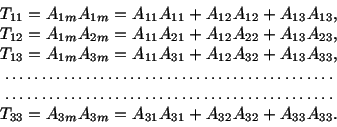Consider the following system of three equations:
 |
(2.2.1) |
These can be shortened to
 |
(2.2.2) |
An index which appears only once in each term of an
equation such as the index  in eqn. (2.2.2) is called a ``free index''. A
free index takes on the integral number 1,2, or 3 one at a time. Thus
eqn. (2.2.2) is a short way of writing three equations each having the sum of
three terms on its right-hand side.
in eqn. (2.2.2) is called a ``free index''. A
free index takes on the integral number 1,2, or 3 one at a time. Thus
eqn. (2.2.2) is a short way of writing three equations each having the sum of
three terms on its right-hand side.
Note that the free index appearing in every term of an equation must be
the same. Thus
is a meaningless equation. However, the following
equations are meaningful.
If there are two free indices appearing in an equation such as
 |
(2.2.3) |
then it is a short way of writing 9 equations. For example,
eqn. (2.2.3) represents 9 equations; each one has the sum of 3 terms on the
right-hand side. In fact
Again, equations such as
are meaningless.

